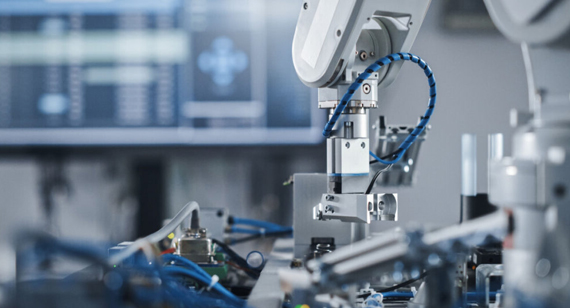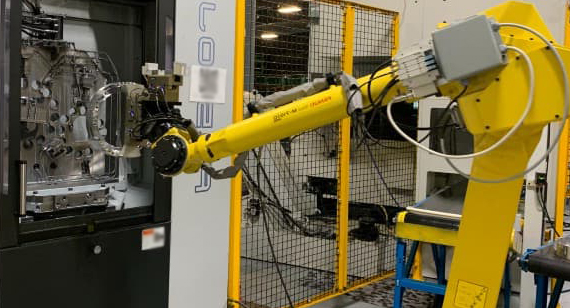15 years one-stop China custom CNC machining parts factory
 266 |
Published by VMT at Oct 24 2024
266 |
Published by VMT at Oct 24 2024
In the rapidly evolving landscape of manufacturing, CNC robots have emerged as a transformative force, reshaping the way components are machined and assembled. These automated systems offer unparalleled precision, efficiency, and flexibility, making them an essential tool in modern manufacturing environments. This article delves into the intricacies of CNC robots, exploring their functionalities, advantages, and the pivotal role they play in automated machining processes.
Robotic machining involves the use of robotic systems integrated with CNC (Computer Numerical Control) technology to automate the manufacturing process. CNC robots can perform a variety of machining tasks, including milling, drilling, and grinding, with high levels of accuracy and repeatability. These robots are equipped with sophisticated software that enables them to interpret complex designs and execute machining operations with minimal human intervention.
The integration of robotics into CNC machining allows manufacturers to streamline their operations, reduce lead times, and enhance product quality. By leveraging advanced algorithms and sensors, CNC robots can adapt to changes in the manufacturing environment, ensuring optimal performance under varying conditions. This adaptability not only improves efficiency but also extends the range of applications for which CNC robots can be employed.

1. Automation
The primary advantage of CNC robots is their ability to automate repetitive tasks, significantly reducing the need for manual labor. Automation enhances productivity by allowing machines to operate continuously without breaks, thus maximizing output.
2. Increased Speed
CNC robots can execute machining operations at speeds that far exceed those achievable by human operators. This rapid execution translates into shorter production cycles, enabling manufacturers to meet tight deadlines and respond swiftly to market demands.
3. Improved Accuracy and Precision
Robotic systems are engineered to perform tasks with high precision, ensuring that every component is manufactured to exact specifications. This level of accuracy minimizes the risk of defects and reduces waste, ultimately leading to cost savings.
4. Greater Flexibility
CNC robots can be programmed to handle a wide variety of tasks, from simple operations to complex machining processes. This versatility allows manufacturers to switch between different production runs without the need for extensive reconfiguration, making them ideal for custom CNC machining projects.
5. Material Compatibility
CNC robots can work with a diverse range of materials, including metals, plastics, and composites. This adaptability ensures that manufacturers can use the best material for each application without being limited by the capabilities of traditional machining methods.
6. Surface Treatment
Beyond machining, CNC robots are capable of performing various surface treatment processes, such as polishing and coating. This capability streamlines production by combining multiple processes into a single operation.
7. Cost-effectiveness
While the initial investment in CNC robotics may be significant, the long-term savings achieved through increased efficiency, reduced labor costs, and minimized material waste can outweigh these upfront expenses.
8. More Complex Tasks
CNC robots excel at executing complex machining tasks that would be challenging or impossible for human operators. This capability allows manufacturers to explore new design possibilities and innovate their product offerings.
9. Safety
By automating hazardous tasks, CNC robots enhance workplace safety. They can operate in environments that may pose risks to human workers, thereby reducing the likelihood of accidents and injuries.
In the realm of CNC robotics, several key components are commonly produced through CNC machining. These parts are crucial for the functionality and efficiency of robotic systems.
Common CNC Robot Parts Made by CNC Machining:
CNC Robot Arms: The robotic arm is the core component of any CNC robot, providing the necessary movement and range of motion required for machining operations.
End Effectors: These are the tools or devices attached to the end of the robotic arm that interact with the workpiece. End effectors can be grippers, cutters, or specialized tools designed for specific machining tasks.
Customized Fixtures and Jigs: These components hold the workpiece in place during machining, ensuring stability and accuracy throughout the process.
Sensors and Controllers: Integrated sensors and control systems allow CNC robots to perform tasks with precision and adjust to variations in the environment or workpiece characteristics.
CNC robots are increasingly becoming commonplace in machining operations across various industries. Their ability to deliver fast production speeds, high manufacturing accuracy, and smooth surface treatment makes them an attractive option for manufacturers looking to enhance their processes.
Additionally, CNC robots can perform multiple tasks within a single production cycle, further increasing their utility. From loading and unloading materials to executing complex machining sequences, these automated systems are redefining efficiency standards in the manufacturing sector.
While CNC machines and robots share similarities, they differ significantly in their capabilities and applications.
1. CNC Machines Are Limited in Their Operation
CNC machines typically perform specific tasks, such as milling or turning, whereas robots are designed for a broader range of operations, including material handling, assembly, and more.
2. CNC Machines Require Human Input
Traditional CNC machines often necessitate human operators to set up, monitor, and adjust operations. In contrast, CNC robots can operate autonomously, reducing the need for constant human oversight.
3. Robots Perform Multiple Tasks More Efficiently
Robots are capable of switching between tasks without extensive reconfiguration, allowing for a more flexible manufacturing process. This efficiency is particularly beneficial for custom CNC machining applications.
4. Accuracy
While both CNC machines and robots offer high levels of accuracy, robotic systems are designed to maintain consistent performance across various tasks and conditions, enhancing overall reliability.
5. Versatility
CNC robots can adapt to different processes and materials, while CNC machines are often restricted to specific functions and setups.
6. Rigidity
CNC machines typically have a rigid structure designed for stability during machining. Robots, on the other hand, prioritize flexibility and mobility to navigate different workspaces.
7. Workspace
CNC robots can operate in dynamic environments and workspaces, while CNC machines usually require dedicated setups and fixtures.
8. Affordability
Though the initial investment in CNC robots may be higher, the potential for cost savings in labor and increased productivity can make them a more economical choice in the long run.
CNC robots come in various forms, each designed for specific applications and industries. Understanding these different types can help manufacturers choose the right solution for their needs.

Cartesian Robots
Cartesian robots operate on three linear axes, allowing for precise movement along the X, Y, and Z coordinates. They are known for their straightforward design and ease of programming.
Applications of Cartesian Robots:
Articulated Robots
Articulated robots have rotary joints, giving them a greater range of motion and flexibility compared to Cartesian robots.
Typical Applications of Articulated Robots:
SCARA Robots
SCARA (Selective Compliance Assembly Robot Arm) robots are designed for high-speed, precision tasks. They can move in a planar motion, making them ideal for applications requiring lateral movement.
Applications of SCARA Robots:
Collaborative Robots
Collaborative robots, or cobots, are designed to work alongside human operators safely. They are equipped with sensors that allow them to detect and respond to human presence.
Applications of Collaborative Robots:
While CNC robots offer significant advantages, they are unlikely to completely replace CNC machines. Instead, they complement traditional machining processes by automating tasks that are repetitive or require high precision. The integration of both technologies can lead to enhanced efficiency, allowing manufacturers to maximize their production capabilities.

The evolution of CNC robotics has been marked by rapid advancements in technology, enabling more sophisticated and capable systems. As industries continue to demand higher efficiency and productivity, the role of CNC robots in automation is set to expand further.
The future of CNC robotics is promising, with trends indicating increased integration of artificial intelligence, machine learning, and IoT (Internet of Things) technologies. These advancements will enhance the capabilities of CNC robots, making them even more adaptable and efficient in responding to changing manufacturing needs.
At VMT, we specialize in providing high-quality CNC machining services tailored to the needs of the robotics industry. Our expertise in custom CNC machining ensures that you receive precision-engineered robot parts that meet the highest standards of quality and performance.
CNC robots represent a significant leap forward in automated machining, offering numerous advantages over traditional manufacturing methods. As industries continue to evolve, the integration of robotics into CNC machining processes will play a crucial role in enhancing productivity, accuracy, and efficiency. By understanding the various types of CNC robots and their applications, manufacturers can make informed decisions that will drive their success in an increasingly automated world.
What is CNC in Robotics?
CNC in robotics refers to the integration of Computer Numerical Control technology with robotic systems, allowing for automated machining and manufacturing processes.
What is a Robotic Arm?
A robotic arm is a type of mechanical arm that is programmable and can perform a range of tasks, including machining.
What are the Most Common Types of Robots in Manufacturing?
Common types include Cartesian robots, articulated robots, SCARA robots, and collaborative robots.
What is the Difference Between a CNC Router and a Robot?
A CNC router is a specific tool for cutting materials, while robots can perform a wider array of tasks.
Is CNC Artificial Intelligence?
CNC itself is not AI, but robotic systems may incorporate AI to enhance their functions.
